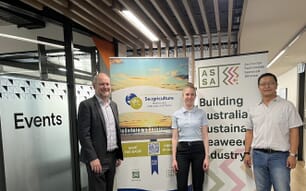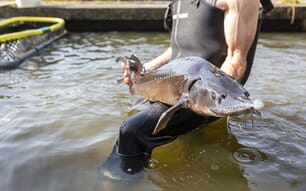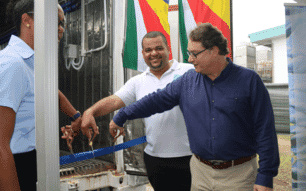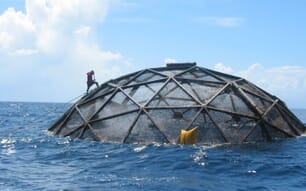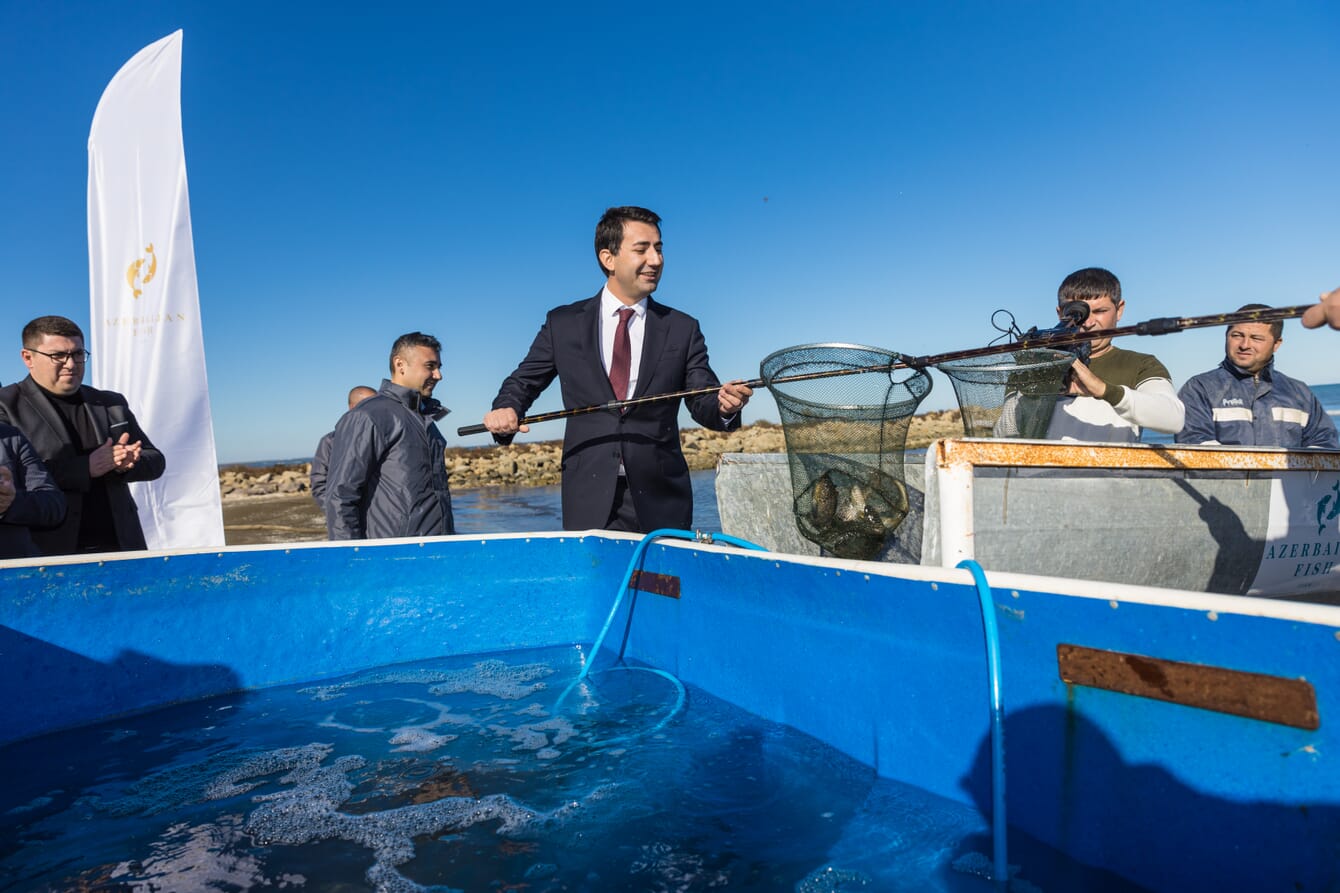
© Azerbaijan Fish Farm
Azerbaijan Fish Farm (AFF) was founded in 2017, when it took over the country’s first sturgeon farm, beside the estuary of the Kura River on the west coast of the Caspian Sea. Originally established in 1954, despite its rich history the farm required substantial investment and AFF has spent the last seven years modernising the facilities, in a bid to produce both premium sustainable caviar and help to restore a number of threated local species.
As Rufat Tabasaranskiy, who has been CEO of the company since it was founded, explains: “Azerbaijan has always been considered as producer of high quality farm-to-fork products, and LU-MUN Holdings [the parent company of AFF] saw the aquaculture sector as having huge opportunities, especially in sturgeon farming.”
AFF’s setup incudes a river unit, which consists of 60 ha of ponds and a RAS facility which is equipped with Hesy Aquaculture hardware and includes the hatchery and broodstock units. The other half is a saltwater flow-through system, beside the Caspian.
They are producing a range of endemic sturgeon species including, Beluga (Huso huso), Acipenser stellatus, Acipenser persicus, sterlet (Acipenser ruthenus), Acipenser gueldenstaedtii. Sterlet is the fastest growing, taking between 12 and 18 months to produce caviar, while Beluga currently take at least 12 years to mature.
“We’re looking at new methods of farming and feeding that will allow us to harvest the Beluga caviar in year number eight, without sacrificing fish welfare,” Tabasaranskiy – who hired a fish welfare consultant from the UK to ensure that the fish were being kept in the correct biological conditions – explains.
While the company has harvested a number of Beluga which it bought from other operators and then grew to maturity, the first of this species that they grew right the way through from eggs are due to be harvested in three to four years.
“Caviar farming requires huge patience. Fish farming is very similar to wine making in many aspects – such as the relationship between the operational team and the investor. The cost of a mistake is very high – if a mistake is made in feed composition, for example, we will only really understand it in two years,” he reflects.
A race to the bottom
According to Tabasaranskiy, despite the country’s deep historical and cultural connections with caviar, other Azerbaijani companies didn’t have the capabilities to farm sturgeon to the standards required by the international market and the country has for too long been associated with the mass poaching of endangered wild sturgeon.
Meanwhile, he notes that the caviar sectors in the most prolific caviar producing countries – China, Russia and Iran – have been cutting corners in terms of quality.
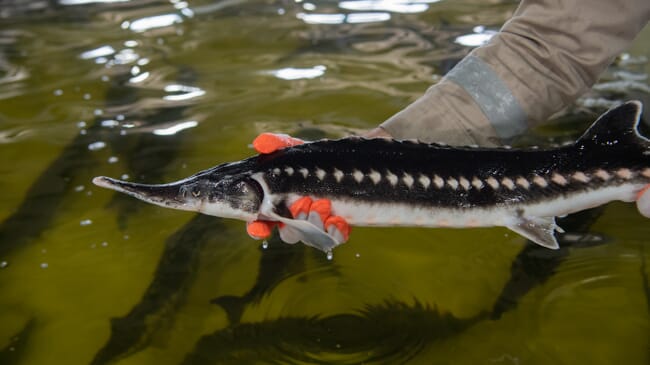
© Azerbaijan Fish Farm
“When we started our two goals were to make caviar sustainable and to ensure it tastes right. In the last 20 years the caviar market has been deteriorating. The Chinese have been doing crazy things in order to lower the cost of production – such as cross-breeding different sturgeon species,” he explains.
In particular, he notes, the race to produce cheaper caviar was accompanied by a focus on the Huso dauricus sturgeon species.
“In the last 20 years, because of the use of dauricus hybrids, all the caviar in the world became green. When restaurants see our caviar – which is greyish or blackish – they don’t understand that this is the proper colour!” Tabasaranskiy exclaims.
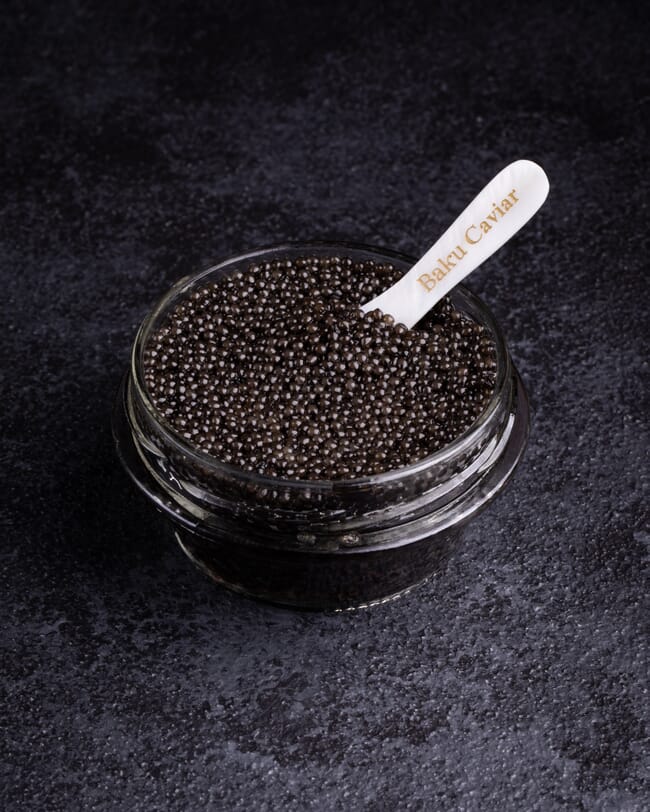
UNlike cheap caviar from hybrid species the company produces the classic black variety © Azerbaijan Fish Farm
Restocking native species
As well as producing a range of sturgeon, the company is looking into producing a range of other fish – both for consumption and for restocking. And one the of elements of the farm that most excites Tabasaranskiy is their programme to breed and then release juvenile Caspian salmon (Salmo ciscaucasicus) – a species even more endangered than sturgeon – in a bid to improve wild stocks.
“For every jar of caviar we sell, we release 10 fish back into the wild, so we’re bringing a net-positive effect for the environment,” he observes.
According to Tabasaranskiy, they released their frist 500 Caspian salmon fingerlings in 2023 and will be able to scale this up significantly, with plans to release 5,000 this year and significntly more in the coming years. Meanwhile they have released 50,000 Acipenser gueldenstaedtii fingerlings.
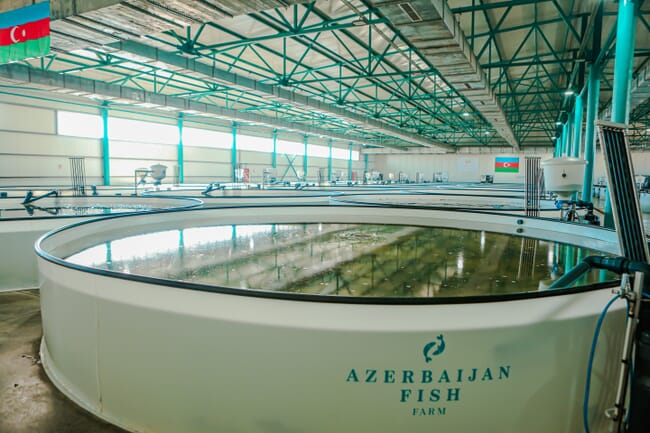
© Azerbaijan Fish Farm
He is now looking for ways to assess the impact of this unique restocking programme.
“We’re currently looking for investors or partners – from here or perhaps from Kazakhstan – to help establish a long-term project to track the hatchery-reared fingerlings. We’re going to radio tag the fish, install beacons to track the migration of these salmon and sturgeons, to see what impacts the oil industry and the shrinking of the Caspian Sea are having on migration routes,” Tabasaranskiy explains.
Major milestones
While AFF has much work still to do, Tabasaranskiy believes that the company has made significant progress.
“We’ve changed attitudes to Azerbaijan’s caviar sector. People had been forgetting about us, and now they position Azerbaijan above Russian and Iranian caviar,” he argues.
He also points to the fact that the company has helped to garner state support for the wider aquaculture sector.
“Buyers of caviar in Europe and Israel saw the potential of aquaculture in Azerbaijan and, after they negotiated with local regulators such as the Ministry of Agriculture and Ministry of Ecology, finally aquaculture started to be subsidised and supported by the local and national governments,” Tabasaranskiy reflects.
In total AFF now employs around 440 people across the seafood side of the business, which also includes retail and imports – with about 20 percent of this figure directly involved on the farm. Intriguingly, these include a significant number of former sturgeon poachers.
“They are some of our best employees. They are very hard working and they have a lot of practical knowledge about sturgeon – things that they would never learn studying for a masters degree,” Tabasaranskiy explains.
Finally Tabasaranskiy points to the company’s wide ranging R&D activities, which he believes are of national significance.
“We’re testing all types of systems to try to understand the optimal conditions for fish farming in each system. We’re looking at water quality, different species of fish – we’re working with trout, with carp, with sturgeon, with Caspian salmon. It’s one of our biggest achievements as fish farming wasn’t well developed in the ex-Soviet countries, but we hope we will change this trend,” he observes.
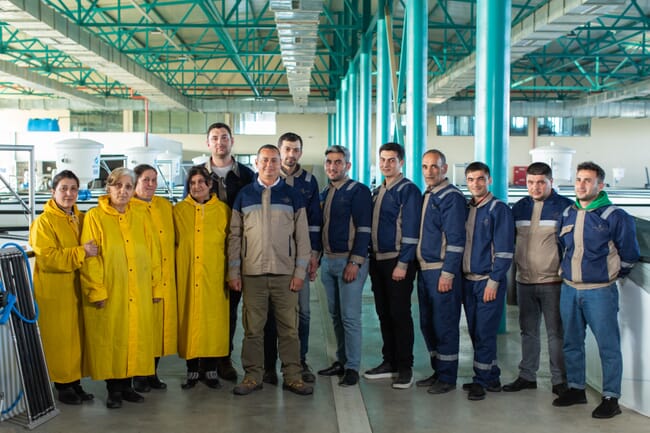
Some of the company's best employees were previously sturgeon poachers
Key challenges
Despite these successes, Tabasaranskiy is realistic about the range of challenges that still need to be overcome.
In practical terms, he notes that the company is working with several universities to map the DNA of Caspian sturgeon – something that is made more challenging by the amount of cross-breeding that has occurred in the caviar farming sector, in Iran, Russia and China over the last few decades.
“Even some of the most reputable caviar distributors have been starting to introduce new types of sturgeons which nobody has never heard of – poor Mr Linnaeus, he would be quite surprised!” Tabasaranskiy jokes.
He also points to the limited number of sturgeon farming specialists available to work with in Azerbaijan.
“We are very keen on building the expertise and have been cherry-picking the specialists who have experience of working with sturgeon in both fresh and salt water – which require completely different skills,” he explains.
As a result, they’ve needed to train up their own specialists, especially when it comes to salt water production, and they have been helped by state-sponsored opportunities to send farmers out to learn more in Europe and North America.
He also points to the need to improve the image of caviar. According Tabasaranskiy, despite the quality and versatility of caviar, it is still associated with “Russian mafia and oil oligarchs”.
This a perception he’s desperate to change and he believes that there’s a market for ethical and sustainable caviar, such as that produced by AFF.
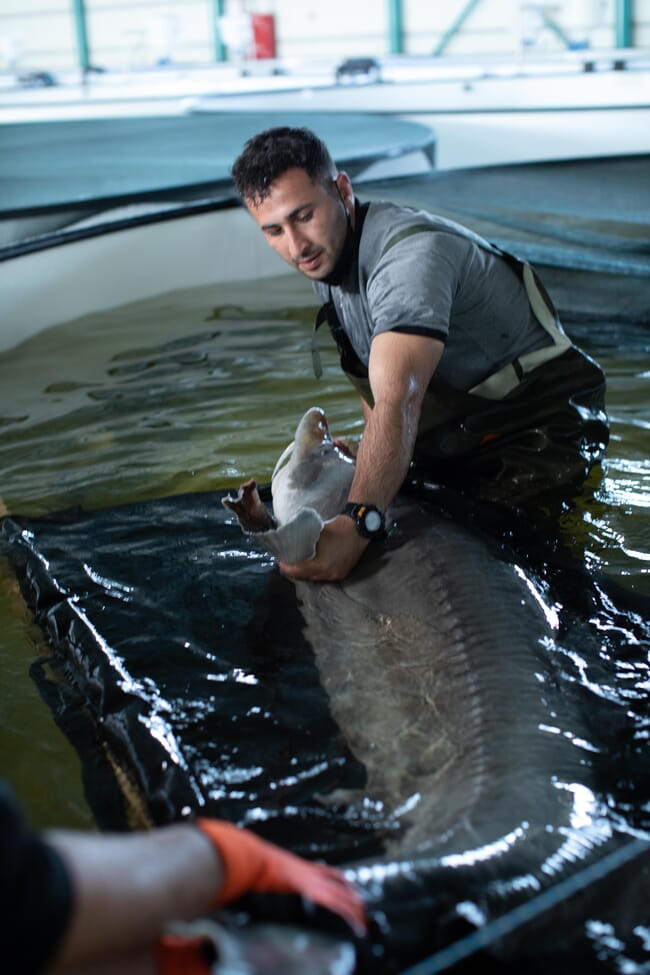
© Azerbaiijan Fish Farm
Plans for the future
Looking ahead, Tabasaranskiy says he hopes to open a guesthouse on the farm, for hosting visiting researchers, tourists and potential customers.
And he also aims to scale up production from current levels of 2 tonnes of caviar and 40 tonnes of meat a year.
“Our plan is to produce 9.2 tonnes of caviar – and 170 tonnes of sturgeon meat – a year by 2026. It would make us one of the biggest producers in the region, but it would only be around 10 percent of what the biggest producers in China are producing – I’ve heard they are around 100 tonnes of caviar per year.
“But we can boast that we have a really high quality and sustainable product,” Tabasaranskiy concludes.

